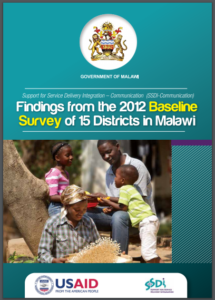Formative Research
Formative Research
Formative research is essential to effective strategy design in any SBCC project. However, integrated SBCC programs must take into account additional nuances and considerations. Before designing your integrated SBCC strategy, you need to conduct some level of formative research to better understand your audiences and the health topics and behaviors you plan to address. Your findings from this research will be used to inform the development of your strategy.
Formative Research for Integrated SBCC
In general, formative research should uncover what people currently know, think, feel and do about the relevant topics and behaviors, and to understand their motivations and barriers to changing or adopting new behaviors. In integrated SBCC programs, the formative research should also help determine whether and how different topics and behaviors relate to one another. Both types of information will help the program and partners determine what to include in an integrated SBCC strategy, and provide insight on how best to do it. Engage a wide representation of stakeholders at all levels (e.g., communities, leaders and other stakeholders) when identifying which issues to address.
- gather information about the extent to which audiences (including providers) perceive or experience the topics or behaviors as related, and how they are related;
- identify influencing factors and behavioral determinants common to the behaviors in question;
- provide insights on how to prioritize topics or behaviors in the implementation phase;
- identify clustered behaviors, gateway behaviors and patterns of household/community communication that foster change;
- observe communication across behaviorally related areas to understand the shared goals that unify seemingly diverse behaviors (e.g., parental investment as a unifying goal);
- identify ways to gain maximum synergy and added value from integration;
- reveal the extent to which audiences are already touched by or interacting with integrated SBCC or integrated services;
- observe communication cascades (e.g., word-of-mouth, discussion-partners, spousal communication and provider/client interactions) around different issues to understand how communication shapes decision-making and action;
- inform an integrated theory of change;
- identify how to segment and appeal to audiences in the context of integration, including understanding people’s desires, articulated and unmet needs;
- identify potential conflicts and unintended consequences of integrated SBCC;
- suggest monitoring and evaluation (M&E) indicators specific to integrated programs; and
- develop clear integration-specific (and other) research questions.
Formative Research Methodologies
Formative research methodologies may include more traditional approaches, such as focus group discussions (FGDs) or in-depth interviews (IDIs). Less traditional, user-centered ethnographic techniques include direct observation, immersion, mystery client experiences, interactions with spaces, customer journey mapping, photo diaries, photo elicitation and card sorts. These less conventional methodologies can help provide more well-rounded perspectives of the target audience’s understanding and experience with your topic areas, and yield unexpected, actionable insights. For more information on how to conduct formative research, review the Resources on at the end of this section, including How to Conduct Qualitative Formative Research, the Total Market Approach, Trials of Improved Practices and human-centered design research techniques.
In integrated SBCC programming, it is especially important to seek sources of information beyond your beneficiaries to inform your programming. Interview topical, behavioral and/or integration experts, for example, to gather important lessons learned and to gain new perspectives on your topics and how they might be linked. Conduct literature reviews on similar integrated interventions that have been implemented elsewhere for important guidance on program design, including both peer-reviewed articles and gray literature. The stakeholder and environmental analyses in Laying the Foundation are also types of formative research meant to inform program design and implementation.
Regardless of which research methodologies you use, it is essential to probe deep into the underlying behavioral determinants that influence a decision or behavior. After identifying a particular behavioral challenge, ask a series of follow-up questions to uncover the root cause of the problem.
Definitions
Tips
See a Sample Interview
SSDI used FGDs, IDIs, a mapping process and extensive visuals in their formative research process. They designed the research to address questions such as:
- What do people value?
- How do they perceive health?
- Is HIV more dangerous than malaria or not?
- How do they perceive the value of losing a child?
- What is the value of a woman?


